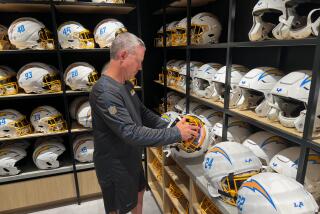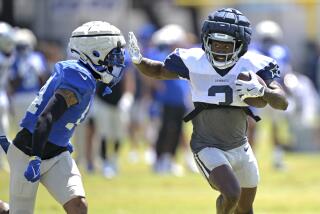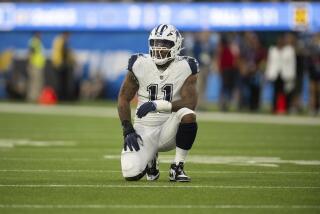Insider Training
SAN ANTONIO — Three weeks after Ringling Bros. packed the tents and rolled out of town, the real circus arrived at the Alamodome.
The Dallas Cowboys have moved their training camp to the air-conditioned stadium and--with an HBO camera crew in tow--have searched for new ways to pump life into a humdrum rite of summer.
Some changes have worked. The players, coaches and fans love the reprieve from the 100-degree temperatures and wilting humidity, and the team is easily on track to draw more than 100,000 spectators this summer. All that for a team coming off a 5-11 season.
Some changes have flopped. When camp opened Saturday, the Cowboys blasted rock music through the stadium speakers, ran a continuous loop of commercials on the Jumbotrons, and hired a zany master of ceremonies to work the crowd of thousands. He came up with these zingers:
“Laredo’s in the house!”
“Hey, folks, we’ve got a fan here all the way from Germany!”
And, in a blissful moment of calm, “I can’t heeeear you!”
All the while, Rowdy, the overstuffed Cowboy mascot, zoomed around the field on an all-terrain vehicle, weaving around the knee-high sideline billboards and the inflatable Pepsi and Miller Lite bottles. No one seemed to notice when he accidentally plowed into an unsuspecting photographer. Fans cheered everything from stretching exercises to punting drills. Landry & Staubach has gone Siegfried & Roy.
Finally, after coaches complained they were having a tough time doing their jobs, the Cowboys turned down the music and pulled the plug on the emcee. Training camp started to feel like training camp again.
Well, almost. Life inside the climate-controlled bubble is so comfortable that some players have taken to calling it Club Med. The Cowboys paid $120,000 to have the south parking lot transformed into a grass practice field, but the sod strips have yet to grow together. The field is a checkerboard of inch-wide seams filled with sand. Emmitt Smith, on the verge of breaking the NFL rushing record, took one look at the surface and refused to practice on it, unwilling to risk his knees.
Groundskeepers, armed with high-powered hoses and buckets of fertilizer, are in a mad scramble to get the outside field ready as soon as possible. Inside, the players are practicing on RealGrass, which is gushy-soft and looks like AstroTurf in need of a mowing. They say they love it, and the Cowboys hope to surface Texas Stadium with it this season. The benefit to practicing inside also could be a drawback for a team that used to spend summers in the sweltering heat of Austin or Wichita Falls.
“We have been a team historically that has said, ‘Hey, you’ve got to have the heat. We’re going to play in the heat, so we’re going to train in the heat,’ ” said Stephen Jones, director of player personnel and owner Jerry Jones’ son. “People are going to watch us closely to see what kind of success we have and how we respond to it.”
The first test comes tonight, when the Cowboys scrimmage against the expansion Houston Texans at Robertson Stadium on the University of Houston campus. The teams are expecting a crowd of 30,000. Almost that many people were on hand here last Friday to welcome the Cowboys with a kickoff party.
“It was crazy, like a rock concert,” safety Darren Woodson said. “I was one of the last ones to walk out on stage and there were a sea of people out there. It felt like a Super Bowl.... I’ve been here for a long time. I know fanfare. I’ve seen the Troy Aikmans and Michael Irvins of the early ‘90s who couldn’t walk through a hotel without getting mobbed. It was like a rock concert everywhere we went. But for guys like La’Roi Glover, Kevin Hardy and Bryant Westbrook to come in, guys who have never seen that, it just blows their minds.”
Glover formerly played for New Orleans, Westbrook played for Detroit, and Hardy played for Jacksonville, where Coach Tom Coughlin ran a training camp that made basic training look like a garden party.
“It’s called Camp Coughlin,” Hardy said. “He’s a hard-nosed, strictly work, hardly-any-play guy. No sunglasses. Hats off when you walk into a meeting room. No eating in the meeting rooms.
“Out here in stretching, you can take your helmet off and set it on the side. At Camp Coughlin, you’ve got to have your helmet on buckled up in the heat. Practice was full-scale every time you took the field. There wasn’t a lot of joking and having fun on the field. When you’re out there, you’ve got to make a play. Sometimes guys will woof a little bit, but there wasn’t any of that. He was right there on you. When you walked on the field in Jacksonville, you immediately knew who was in charge.
“Here, there’s a ton of people on the sidelines. In Jacksonville, we practiced in a fenced-off area, and everybody is behind the fence, with the exception of the media. Down there, you might have had maybe four television cameras. You come out here and they have 25 or 30. It’s a media frenzy, HBO, ‘Hard Knocks.’ You’re on the field trying to get a play, you try to look and a camera is like right here [holding his palm an inch away from his face].”
Hardy might sound annoyed, but he’s not. How could he be? The Cowboys are staying in an upscale hotel, not a low-rent college dormitory, and they have bellhops lugging their bags. The players spend their days barely breaking a sweat in 72-degree conditions, then explore San Antonio, stroll the Riverwalk, watch the sunset from paddleboats. Not too shabby for the underachieving Cowboys, who join San Diego as the only two teams who have lost at least 10 games in each of the last two seasons.
Some people have questioned whether this cushy, distracting approach will sufficiently prepare the team for the rigors of the season. But it’s hard to fault the Cowboys for choosing to keep cool, especially a year after Minnesota Viking Korey Stringer died of heatstroke. Stephen Jones thinks his team could be on the cutting edge.
“We didn’t realize how much more work we could get done when the players weren’t just trying to survive,” he said. “You get out in this 95-, 100-, 105-degree heat, and their mind goes from learning and trying to get better to just, ‘How am I going to make it through these two hours? Am I going to pass out?’ ”
Time will tell if this becomes a trend or simply another quirky Cowboy twist. There have been a lot of those. In the late ‘80s, Tex Schramm, then team president, sold the TV rights to the afternoon workouts in Thousand Oaks to a cable distributor. Fearing opponents might tune in via satellite, Coach Tom Landry shifted drills from the afternoon to the morning session so he could safely install offensive and defensive schemes.
No such worries now. After all, what does Cowboy training camp have to do with football?
More to Read
Go beyond the scoreboard
Get the latest on L.A.'s teams in the daily Sports Report newsletter.
You may occasionally receive promotional content from the Los Angeles Times.











